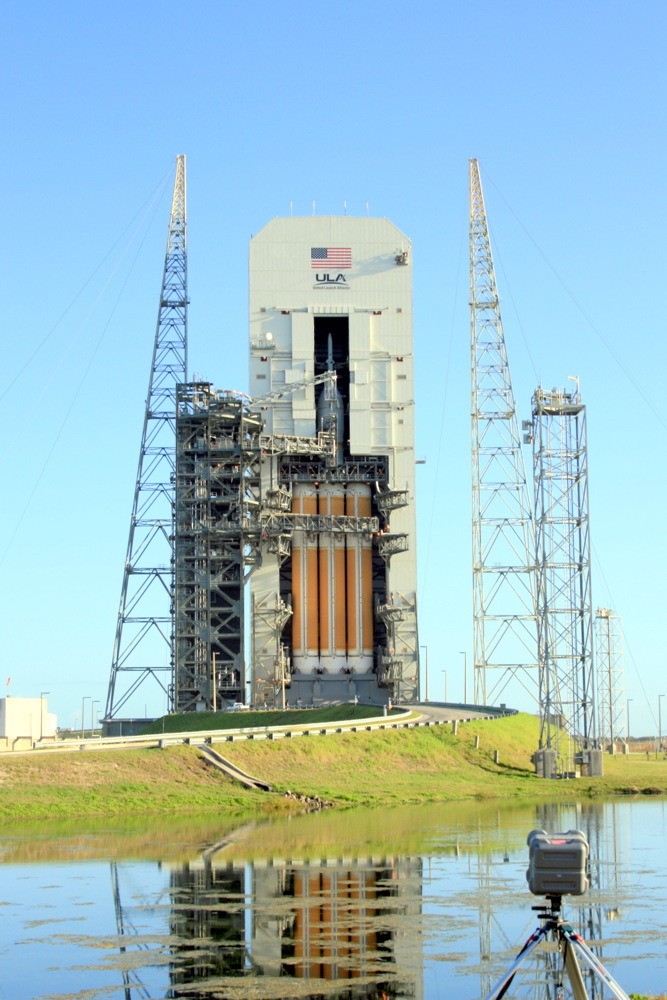NASA's 21st-Century Space Capsule to Make Launch Debut Thursday

NASA's newest capsule, designed to take astronauts deeper into space than ever before, is ready to launch to space for the first time on Thursday (Dec. 4).
The space agency's new Orion space capsule is scheduled to fly to orbit on an unmanned test flight at 7:05 a.m. EST (1205 GMT) from Space Launch Complex 37 here in Cape Canaveral, Florida Thursday before being recovered in the Pacific Ocean 4.5 hours later. Orion is currently positioned on top of the United Launch Alliance Delta 4 Heavy rocket that will deliver it into space on its ambitious test flight, and everything is looking good for launch day.
"On the vehicle side, everything is extremely clean," NASA Orion program manager Mark Geyer told reporters today during a news conference.[Orion's First Test Flight: Full Coverage]
The weather is also looking good for launch. Officials are predicting a 70 percent chance of good weather during the more than 2-hour launch window. The weather forecast at the splashdown site in the Pacific is also favorable.
Orion — which was built for NASA by Lockheed Martin — will orbit Earth twice during its test flight, called Exploration Test Flight-1 (EFT-1). On its second orbit, the spacecraft will climb about 3,600 miles (5,793 kilometers) above Earth's surface, farther than any spacecraft made for humans has flown in more than 40 years.
You can watch the historic Orion flight live on Space.com via NASA TV Thursday at 4:30 a.m. EST (0930 GMT).
Officials on the ground should get some live imagery from Orion throughout the flight. The spacecraft's onboard cameras are expected to capture key events during EFT-1, recording data and even beaming some live pictures down to mission controllers while the capsule is in space.
Get the Space.com Newsletter
Breaking space news, the latest updates on rocket launches, skywatching events and more!
NASA is particularly interested in seeing how Orion's many systems behave in the harsh space environment. Controllers want to see how various parts of the Orion flight system separate during flight. Orion's Launch Abort System — technology designed to pull future astronauts in the capsule out of harm's way in case of a problem during launch — will be jettisoned into space shortly after launch as part of the test.
A mockup of Orion's service module will also detach from the space capsule just before the spacecraft starts to re-enter Earth's atmosphere near the end of the flight. The final version of Orion's service module, designed to help provide support to the crew capsule, is being built by the European Space Agency.
Eventually, NASA plans to use the Orion capsule as part of a system that could bring humans to Mars or an asteroid towed into orbit around the moon for the first time.
Follow Miriam Kramer @mirikramer. Follow us @Spacedotcom, Facebook and Google+. Original article on Space.com.
Join our Space Forums to keep talking space on the latest missions, night sky and more! And if you have a news tip, correction or comment, let us know at: community@space.com.

Miriam Kramer joined Space.com as a Staff Writer in December 2012. Since then, she has floated in weightlessness on a zero-gravity flight, felt the pull of 4-Gs in a trainer aircraft and watched rockets soar into space from Florida and Virginia. She also served as Space.com's lead space entertainment reporter, and enjoys all aspects of space news, astronomy and commercial spaceflight. Miriam has also presented space stories during live interviews with Fox News and other TV and radio outlets. She originally hails from Knoxville, Tennessee where she and her family would take trips to dark spots on the outskirts of town to watch meteor showers every year. She loves to travel and one day hopes to see the northern lights in person. Miriam is currently a space reporter with Axios, writing the Axios Space newsletter. You can follow Miriam on Twitter.









